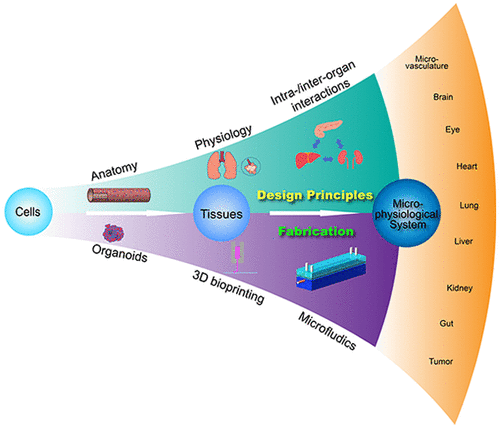当前位置:
X-MOL 学术
›
ACS Biomater. Sci. Eng.
›
论文详情
Our official English website, www.x-mol.net, welcomes your
feedback! (Note: you will need to create a separate account there.)
Microphysiological Systems: Design, Fabrication, and Applications
ACS Biomaterials Science & Engineering ( IF 5.4 ) Pub Date : 2020-05-10 , DOI: 10.1021/acsbiomaterials.9b01667 Kai Wang 1 , Kun Man 1 , Jiafeng Liu 1 , Yang Liu 2 , Qi Chen 3 , Yong Zhou 4 , Yong Yang 1
ACS Biomaterials Science & Engineering ( IF 5.4 ) Pub Date : 2020-05-10 , DOI: 10.1021/acsbiomaterials.9b01667 Kai Wang 1 , Kun Man 1 , Jiafeng Liu 1 , Yang Liu 2 , Qi Chen 3 , Yong Zhou 4 , Yong Yang 1
Affiliation

|
Microphysiological systems, including organoids, 3-D printed tissue constructs, and organ-on-a-chip systems (organ chips), are physiologically relevant in vitro models and have experienced explosive growth in the past decades. Different from conventional, tissue culture, plastic-based in vitro models or animal models, microphysiological systems recapitulate key microenvironmental characteristics of human organs and mimic their primary functions. The advent of microphysiological systems is attributed to evolving biomaterials, micro/nanotechnologies, and stem cell biology, which enable precise control over the matrix properties and the interactions between cells, tissues, and organs in physiological conditions. As such, microphysiological systems have been developed to model a broad spectrum of organs from microvasculature and eyes to lungs and many others to understand human organ development and disease pathology and facilitate drug discovery. Multiorgans-on-a-chip systems have also been developed by integrating multiple associated organ chips in a single platform, which allow study and employment of the organ function from a systematic approach. Here we first discuss the design principles of microphysiological systems with a focus on the anatomy and physiology of organs and, then, review the commonly used fabrication techniques and biomaterials for microphysiological systems. Subsequently, we discuss recent developments in microphysiological systems and provide our perspectives on advancing microphysiological systems for preclinical investigation and drug discovery of human disease.
中文翻译:

微生理系统:设计、制造和应用
微生理系统,包括类器官、3D 打印组织结构和器官芯片系统(器官芯片),是生理相关的体外模型,在过去几十年中经历了爆炸性增长。与传统的组织培养、塑料体外模型或动物模型不同,微生理系统概括了人体器官的关键微环境特征并模拟其主要功能。微生理系统的出现归因于不断发展的生物材料、微/纳米技术和干细胞生物学,它们使得能够精确控制生理条件下的基质特性以及细胞、组织和器官之间的相互作用。因此,微生理学系统已被开发用于模拟从微脉管系统、眼睛到肺等多种器官,以了解人体器官发育和疾病病理学并促进药物发现。多器官芯片系统也通过将多个相关器官芯片集成在一个平台中而开发出来,这使得可以通过系统方法研究和使用器官功能。在这里,我们首先讨论微生理系统的设计原理,重点关注器官的解剖学和生理学,然后回顾微生理系统常用的制造技术和生物材料。随后,我们讨论了微生理系统的最新发展,并提供了我们对推进微生理系统用于人类疾病的临床前研究和药物发现的观点。
更新日期:2020-05-10
中文翻译:

微生理系统:设计、制造和应用
微生理系统,包括类器官、3D 打印组织结构和器官芯片系统(器官芯片),是生理相关的体外模型,在过去几十年中经历了爆炸性增长。与传统的组织培养、塑料体外模型或动物模型不同,微生理系统概括了人体器官的关键微环境特征并模拟其主要功能。微生理系统的出现归因于不断发展的生物材料、微/纳米技术和干细胞生物学,它们使得能够精确控制生理条件下的基质特性以及细胞、组织和器官之间的相互作用。因此,微生理学系统已被开发用于模拟从微脉管系统、眼睛到肺等多种器官,以了解人体器官发育和疾病病理学并促进药物发现。多器官芯片系统也通过将多个相关器官芯片集成在一个平台中而开发出来,这使得可以通过系统方法研究和使用器官功能。在这里,我们首先讨论微生理系统的设计原理,重点关注器官的解剖学和生理学,然后回顾微生理系统常用的制造技术和生物材料。随后,我们讨论了微生理系统的最新发展,并提供了我们对推进微生理系统用于人类疾病的临床前研究和药物发现的观点。















































 京公网安备 11010802027423号
京公网安备 11010802027423号